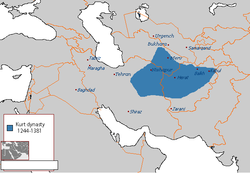Our website is made possible by displaying online advertisements to our visitors.
Please consider supporting us by disabling your ad blocker.
Kart dynasty
Kart dynasty آل کرت | |||||||||
|---|---|---|---|---|---|---|---|---|---|
| 1244–1381 | |||||||||
 The Kart dynasty at its greatest extent | |||||||||
| Status | Monarchy | ||||||||
| Capital | Herat | ||||||||
| Common languages | Persian | ||||||||
| Religion | Sunni Islam | ||||||||
| Malik/Sultan | |||||||||
• 1245 | Malik Rukn-uddin Abu Bakr (first) | ||||||||
• 1370–1389 | Ghiyas-uddin Pir 'Ali (last) | ||||||||
| Historical era | Middle Ages | ||||||||
• Foundation by Malik Rukn-uddin Abu Bakr | 1244 | ||||||||
• Disestablished | 1381 | ||||||||
| |||||||||
| Today part of | Afghanistan Iran Turkmenistan | ||||||||
The Kart dynasty, also known as the Kartids (Persian: آل کرت), was a Sunni Muslim[1] dynasty of Tajik origin closely related to the Ghurids,[2] that ruled over a large part of Khorasan during the 13th and 14th centuries. Ruling from their capital at Herat and central Khorasan in the Bamyan, they were at first subordinates of Sultan Abul-Fateh Ghiyāṣ-ud-din Muhammad bin Sām, Sultan of the Ghurid Empire, to whom they were related,[3] and then as vassal princes within the Mongol Empire.[4] Upon the fragmentation of the Ilkhanate in 1335, Mu'izz-uddin Husayn ibn Ghiyath-uddin worked to expand his principality. The death of Husayn b. Ghiyath-uddin in 1370 and the invasion of Timur in 1381, ended the Kart dynasty's ambitions.[4]
- ^ Farhad Daftary, The Ismāī̀līs: Their History and Doctrines (Cambridge University Press, 1999), 445.
- ^
- Martijn Theodoor Houtsma (1993). E.J. Brill's first Encyclopaedia of Islam, 1913-1936, Том 1. E.J. Brill p. 546 pp.154. ISBN 9789004097872. Retrieved 21 August 2017.
"The Kurt dynasty which ruled Afghanistan under the Persian Mongols were also Tadjiks. In the south, spreading into BalocistBn the population of Tadjik origin goes by the name of DehwSr or Dehkan, i. e. villager, and north of the Hindn- kush ..."
- Mukesh Kumar Sinha (2005). The Persian World: Understanding People, Polity, and Life in Iran, Afghanistan, and Tajikistan. Hope India Publications p. 151 pp.30. ISBN 9788178710686. Retrieved 21 August 2017.
"The indigenous Kurt dynasty, a Tajik line related to the Ghurids"
- Mahomed Abbas Shushtery (1938). "Historical and cultural aspects". Bangalore Press pp.76. Retrieved 21 August 2017.
"The inhabitants of Seistan are a mixture of Tajiks and Baluchis. Some of them ... The Ghori and Kurt dynasties who ruled in Afghanistan were Tajiks ... "
- M. J. Gohari (2000). The Taliban: Ascent to Power. Oxford University Press p. 158 pp.4. ISBN 9780195795608. Retrieved 21 August 2017.
"The indigenous Kert (Kurt) dynasty, a Tajik line related to the Ghurids, ruled at Herat"
- Farhad Daftary, The Ismāī̀līs: Their History and Doctrines, (Cambridge University Press, 1999), 445.
- Martijn Theodoor Houtsma (1993). E.J. Brill's first Encyclopaedia of Islam, 1913-1936, Том 1. E.J. Brill p. 546 pp.154. ISBN 9789004097872. Retrieved 21 August 2017.
- ^ M.J. Gohari, Taliban: Ascent to Power, (Oxford University Press, 2000), 4.
- ^ a b C.E. Bosworth, The New Islamic Dynasties, (Columbia University Press, 1996), 263.
Previous Page Next Page


